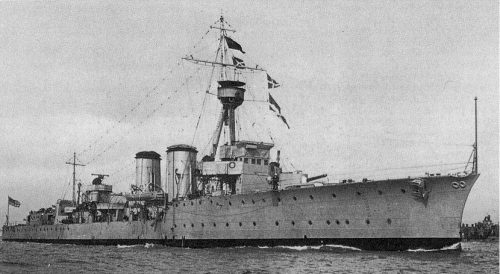
NAVYPEDIA
 Support the project with paypal
Support the project with paypal
Photo

Champion 1919 Many thanks to Wolfgang Stöhr for additional information on this page.
Ships
| Name | No | Yard No | Builder | Laid down | Launched | Comp | Fate |
|---|---|---|---|---|---|---|---|
| Calliope | 76,23, 78 | Chatham DYd | 1.1.1914 | 17.12.1914 | 6.1915 | sold for BU 8.1931 | |
| Champion | C8, 37, 25 | 472 | Hawthorn Leslie, Hebburn | 9.3.1914 | 29.5.1915 | 12.1915 | sold for BU 7.1934 |
Technical data
| Displacement normal, t | 4228 |
|---|---|
| Displacement full, t | 4695 |
| Length, m | 135.9 |
| Breadth, m | 12.6 |
| Draught, m | 4.50 |
| No of shafts | Calliope: 4 Champion: 2 |
| Machinery | Calliope: 4 sets Parsons geared steam turbines, 6 Yarrow boilers Champion: 2 sets Parsons geared steam turbines, 6 Yarrow boilers |
| Power, h. p. | Calliope: 37500 Champion: 40000 |
| Max speed, kts | Calliope: 29.5 Champion: 29 |
| Fuel, t | oil 805 - 895 |
| Endurance, nm(kts) | 2000(28) |
| Armour, mm | belt: 102 - 38, deck: 25, CT: 152, gun shields: 102 |
| Armament | 2 x 1 - 152/45 BL Mk XII, 8 x 1 - 102/45 QF Mk V, 1 x 1 - 76/23 13pdr 6cwt QF Mk V, 4 x 1 - 47/40 3pdr Hotchkiss Mk I, 2 - 533 TT (beam) |
| Complement | 368 |
Standard scale images

Calliope 1916
Graphics
Project history
In the last two cruisers of the 1913 Programme the opportunity was taken to introduce gearing to improve the efficiency of the turbines. A 4-shaft arrangement was tried in the Calliope but the double helical type of gearing and the 2-shaft arrangement in Champion proved more successful. On trials she reached 28.2kts at 31,418shp and 29.5kts at 41,188shp, whereas the fastest direct-drive ships had only reached 29kts, at much higher revolutions. By rearranging the boilers it proved possible to reduce the funnels to two, marking the beginning of the classic 'C' class cruiser profile, with one fat fore funnel and a thinner after funnel. They were completed with the extra pair of 102mm guns on the forecastle, but in 1916-17 these gave way to a third 152mm gun. A year later a fourth 152mm was mounted on a platform abaft the funnels, and the remaining 102mm guns were removed.
Ship protection
Armoured belt protected ship at full length, its thickness was 102mm abreast machinery spaces (76mm armour on 25mm plating), 51mm (38mm armour on 13mm plating) aft and 38mm (25mm armour on 13mm plating) fore. Belt was closed by aft 25mm bulkhead near stern. It extended to main deck (and to upper deck abreast machinery). Machinery and steering gear were covered by 25mm deck.
Modernizations
1916 - 1917, both: - 2 x 1 - 102/45; + 1 x 1 - 152/45 BL Mk XII
1917 - 1918, Calliope: - 6 x 1 - 102/45, 1 x 1 - 76/23; + 1 x 1 - 152/45 BL Mk XII, 2 x 1 - 76/45 20cwt QF Mk I, 2 x 2 - 533 TT
1917 - 1918, Champion: - 6 x 1 - 102/45, 1 x 1 - 76/23; + 1 x 1 - 152/45 BL Mk XII, 1 x 1 - 102/45 QF Mk V (AA), 2 x 2 - 533 TT
1918, Calliope: + flying-off platform and 1 airplane, sweeps
1918, Champion: + winch for kite balloon
1919, Calliope: - flying-off platform and airplane
3/1920, Calliope: - 2 x 2 - 533 TT; + 2 x 1 - 40/39 2pdr QF Mk II
1924, Champion:+ 2 x 1 - 40/39 2pdr QF Mk II
1927, Champion: - 1 x 1 - 102/45, 2 x 2 - 533 TT; + 2 x 1 - 76/45 20cwt QF Mk I
Naval service
Calliope suffered severe boiler room fire 19.3.1916 but repaired before Jutland, second fire now in engine room was in October 1919, repaired till March 1920. Champion served as gunnery TS from May 1925 and was attached to Signal School in 1928.
Many thanks to Wolfgang Stöhr for additional information on this page.
 HOME
HOME FIGHTING SHIPS OF THE WORLD
FIGHTING SHIPS OF THE WORLD UNITED KINGDOM
UNITED KINGDOM CRUISERS
CRUISERS CALLIOPE light cruisers (2, 1915)
CALLIOPE light cruisers (2, 1915)
